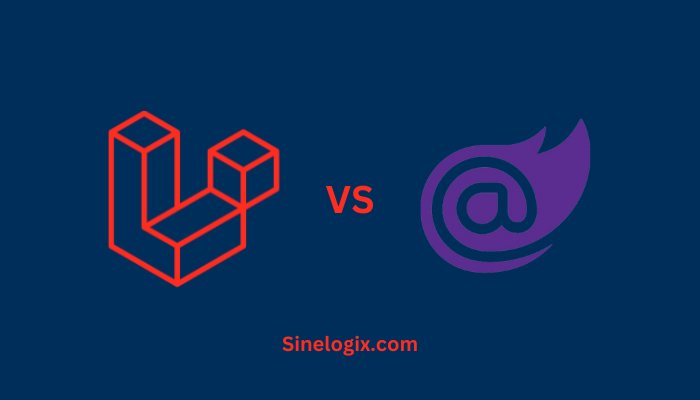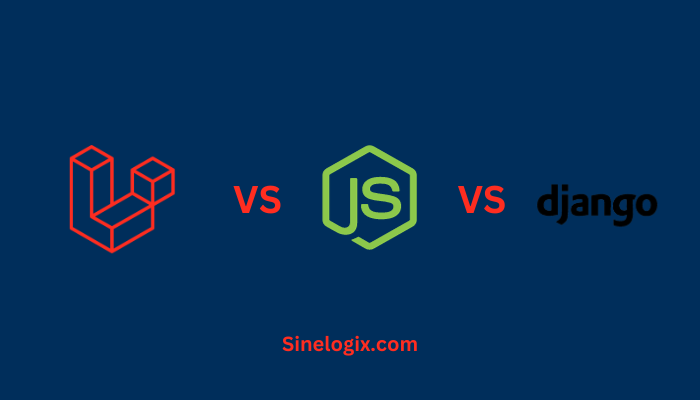In the dynamic landscape of web development, choosing the right framework is crucial for the success of your project. Laravel, a robust PHP framework, and Blazor, a modern framework from Microsoft, represent two powerful options with distinct strengths. In this comprehensive comparison, we’ll delve into 20 critical aspects to help you make an informed decision based on your project’s specific requirements.
Introduction
Web development frameworks play a pivotal role in shaping the architecture, performance, and overall success of your projects. Laravel, a mature PHP framework, and Blazor, a modern framework from Microsoft, cater to different technology stacks but share the common goal of streamlining web development. This detailed analysis aims to unravel the nuances of Laravel and Blazor across various dimensions, empowering you to make a well-informed choice.
1. Architecture
Laravel: Laravel embraces the Model-View-Controller (MVC) architecture, providing a structured and organized approach to building applications. The MVC pattern separates concerns, facilitating code organization and maintainability. Laravel’s architecture is well-suited for projects of varying sizes, offering a robust foundation for scalable development.
Blazor: Blazor introduces a component-based architecture, aligning with modern web development paradigms. Components encapsulate UI elements and logic, fostering a modular and reusable approach. With server-side and client-side hosting models, Blazor adapts its architecture to accommodate different deployment scenarios, making it versatile for various project requirements.
2. Language
Laravel: Laravel is a PHP framework, leveraging the versatility and widespread adoption of PHP for web development. PHP’s expressive syntax and extensive ecosystem make Laravel an attractive choice for developers seeking a powerful yet accessible language for their projects.
Blazor: Blazor supports C#, a statically-typed language from Microsoft. C# brings strong typing and modern language features to the world of web development. Developers familiar with C# or those working in .NET environments can seamlessly transition to Blazor, promoting code consistency across the entire tech stack.
3. Security
Laravel: Security is a cornerstone of Laravel’s design. The framework includes built-in features like Cross-Site Request Forgery (CSRF) protection, encryption, and a dedicated security team. Laravel’s commitment to security, coupled with regular updates, ensures a robust defense against common web vulnerabilities.
Blazor: As a client-side framework, Blazor inherits security practices from .NET and the underlying hosting model (server-side or client-side). Developers need to adhere to secure coding practices and stay informed about potential security risks in the .NET ecosystem.
4. Performance
Laravel: Laravel optimizes performance through features like opcode caching and efficient asset compilation using Laravel Mix. These optimizations contribute to faster response times and overall application performance. Laravel’s performance capabilities make it suitable for a wide range of applications, from small projects to large-scale enterprise applications.
Blazor: Blazor’s performance depends on the hosting model. In server-side Blazor, the server manages UI updates, reducing the amount of data transmitted to the client. Client-side Blazor, on the other hand, shifts the processing to the browser, offering a responsive user experience. Developers can choose the hosting model based on project requirements and performance considerations.
5. Community and Ecosystem
Laravel: Laravel boasts a large and active community, contributing to a vast ecosystem of packages and plugins. The community’s engagement ensures continuous improvement, extensive documentation, and a wealth of resources for developers. Laravel’s ecosystem simplifies development tasks by providing solutions for a broad spectrum of functionalities.
Blazor: Being a relatively newer framework, Blazor’s community is growing steadily, especially within the .NET ecosystem. Developers can benefit from the extensive .NET ecosystem, including libraries and tools, while contributing to the evolving Blazor community.
6. Database Support
Laravel: Laravel’s Eloquent ORM supports multiple databases, including MySQL, PostgreSQL, and SQLite. This flexibility allows developers to choose the database that best fits their project needs. Eloquent’s intuitive syntax and powerful features make database interactions seamless and enjoyable for developers.
Blazor: As a front-end framework, Blazor doesn’t dictate specific database choices. Database interactions in a Blazor application are typically managed by the backend technology used in conjunction with the framework, offering flexibility in adapting to diverse database systems.
7. REST API Development
Laravel: Laravel is renowned for its exceptional support for building RESTful APIs. The framework provides built-in features and additional packages that simplify API development. Laravel’s dedicated API tools, such as resource controllers and Eloquent resources, streamline the process, making it an ideal choice for projects with robust API requirements.
Blazor: While Blazor is primarily a front-end framework, it can interact with RESTful APIs by leveraging .NET libraries or JavaScript interop. The actual API development would be handled by the backend technology chosen to work with Blazor.
8. SignalR Support
Laravel: Laravel provides support for real-time features through tools like Laravel Echo and Pusher. These facilitate the integration of WebSockets, enabling dynamic, real-time user experiences. Laravel Echo simplifies WebSocket implementation, making it easy for developers to incorporate real-time features into their applications.
Blazor: Blazor Server supports real-time features through SignalR, a library for building real-time web functionality. With Blazor Server, developers can create interactive and responsive applications by leveraging SignalR for bi-directional communication between the client and server.
9. Testing
Laravel: Laravel comes equipped with PHPUnit, a robust testing framework that fosters a comprehensive testing environment. Laravel’s testing tools allow developers to write unit tests, feature tests, and browser tests effortlessly. PHPUnit’s integration with Laravel’s testing suite ensures reliable and efficient testing processes.
Blazor: Testing in Blazor is often performed using .NET testing tools such as xUnit or NUnit. As Blazor components can contain both markup and C# code, unit testing and integration testing can be applied to ensure the reliability of components.
10. Scalability
Laravel: Laravel is scalable, and its scalability shines in medium to large-sized projects with moderate traffic. Laravel Horizon, a robust job queue monitoring tool, enhances scalability by efficiently handling tasks in the background. For larger projects, Laravel’s modular design and support for microservices contribute to scalability.
Blazor: The scalability of a Blazor application depends on the chosen hosting model. Blazor Server apps can scale well for applications with a moderate number of concurrent users, while Blazor WebAssembly apps offer scalability by offloading processing to the client, making them suitable for various scalability requirements.
11. Documentation
Laravel: Laravel offers comprehensive documentation, providing developers with clear guidance and examples for effective implementation. Laravel’s documentation covers everything from installation to advanced features, making it a valuable resource for both beginners and experienced developers.
Blazor: Maintaining high-quality documentation, Blazor provides detailed guides, examples, and API references. The documentation is structured to cater to developers of varying skill levels, aiding in the efficient implementation of Blazor features and best practices.
12. Middleware
Laravel: Implementing middleware in Laravel allows developers to handle HTTP requests at various stages, providing a centralized mechanism for request processing. Laravel’s middleware system allows developers to inject custom logic before or after the request is handled, enhancing flexibility and customization.
Blazor: As a front-end framework, Blazor doesn’t include a middleware system like Laravel. Middleware functionality for backend processes would depend on the chosen backend technology used in conjunction with Blazor.
13. Code Organization
Laravel: Following a convention-over-configuration paradigm, Laravel simplifies code organization and ensures consistency across projects. Laravel’s folder structure and naming conventions encourage developers to organize code in a way that aligns with best practices, streamlining collaboration and onboarding.
Blazor: Blazor promotes a component-based structure, encouraging developers to create reusable and modular components. The framework’s emphasis on components and the separation of concerns contributes to code maintainability. Developers familiar with .NET practices will find Blazor’s code organization intuitive.
14. Authentication
Laravel: Laravel simplifies authentication with built-in features such as Laravel Passport, streamlining the process of implementing secure authentication mechanisms. Laravel Passport provides a full OAuth2 server implementation with minimal configuration, making it easy for developers to integrate secure authentication into their applications.
Blazor: Authentication in a Blazor application is typically handled by the backend technology used in conjunction with the framework. Blazor applications can integrate with authentication mechanisms provided by the .NET ecosystem, ensuring secure user authentication.
15. Dependency Injection
Laravel: Laravel employs a powerful Inversion of Control (IoC) container for managing class dependencies, enhancing code maintainability. The IoC container allows developers to inject dependencies into classes rather than hard-coding them, promoting loose coupling and making code more modular and testable.
Blazor: As part of the .NET ecosystem, Blazor supports dependency injection, allowing developers to manage and inject dependencies into components. The use of dependency injection in Blazor follows .NET best practices, contributing to clean and organized code.
16. Learning Curve
Laravel: Known for its beginner-friendly nature, Laravel features straightforward syntax and extensive documentation, reducing the learning curve. Laravel’s documentation includes guides, tutorials, and examples that cater to developers of all skill levels. The framework’s simplicity and expressive syntax make it an ideal choice for those new to web development.
Blazor: For developers familiar with C# and .NET, Blazor offers a relatively smooth learning curve. However, those new to C# or .NET may experience a learning curve, especially when adapting to the component-based architecture. Blazor’s documentation serves as a valuable resource for developers navigating the learning process.
17. Community Support
Laravel: Enjoying strong community support, Laravel features forums, conferences, and a vibrant ecosystem. The community actively contributes to the framework’s improvement, addresses issues, and shares best practices. Laravel’s popularity ensures a robust and engaged community that provides valuable resources for developers.
Blazor: As part of the broader .NET ecosystem, Blazor benefits from the extensive resources and community support surrounding .NET. The .NET community’s collaboration extends to Blazor, fostering a rich ecosystem of libraries, tools, and knowledge sharing.
18. Tooling
Laravel: Laravel’s artisan command-line tools streamline various tasks, enhancing developer productivity with efficient workflows. The artisan CLI provides commands for tasks such as database migrations, testing, and code generation, reducing the manual effort required for routine development tasks.
Blazor: Integrated with Visual Studio and Visual Studio Code, Blazor provides a robust set of tools for development. The tooling includes features for debugging, code completion, and project management, contributing to a seamless development experience.
19. Popularity
Laravel: Embraced widely in the PHP community, Laravel boasts a significant number of projects and companies adopting it for diverse applications. Laravel’s popularity is evident in its extensive usage, community engagement, and the numerous successful projects built with the framework.
Blazor: As a newer entrant in the web development landscape, Blazor has been gaining popularity within the .NET community. Its growing user base is indicative of its appeal and the confidence developers place in the framework for building modern web applications.
20. SEO Friendly
Laravel: Primarily a server-side framework, Laravel renders views on the server before sending them to the client. While this approach provides a fast initial page load, it may not be as SEO-friendly compared to client-side rendering. However, Laravel applications can implement SEO best practices by managing meta tags, sitemaps, and other SEO-related elements.
Blazor: Blazor Server supports server-side rendering, where UI updates are managed on the server. This can contribute to better SEO as search engines can crawl the server-rendered content. Blazor WebAssembly, while offering a more interactive client-side experience, may require additional considerations for SEO, such as pre-rendering or server-side rendering.
Related Articles:
Conclusion
In this comprehensive comparison of Laravel and Blazor across 20 aspects, both frameworks exhibit strengths and considerations. Laravel, rooted in PHP, excels in server-side web development with a rich ecosystem and community support. Blazor, part of the .NET family, introduces modern C# development to the web with a component-based architecture.
Choosing between Laravel and Blazor depends on your project’s requirements, team expertise, and the desired technology stack. Whether you prioritize the versatility of PHP with Laravel or the integration capabilities of C# with Blazor, each framework equips you with powerful tools for successful web development.
By carefully evaluating these aspects, you can make an informed decision that aligns with your project goals, ensuring a robust and efficient development process. As the field of web development continues to evolve, this detailed comparison provides valuable insights for navigating the complexities of modern web application development.




